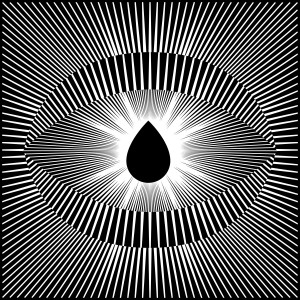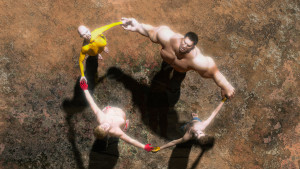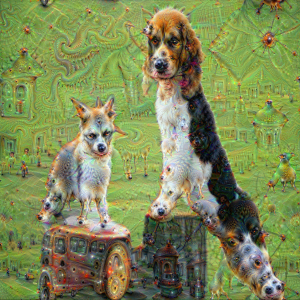Juliette Bibasse
What is it like to own an NFT by Lauren Lee McCarthy that requires the artist to text you "good night" every night before she goes to sleep?

Kanon is an initiative that asks what an art collection should be in the twenty-first century, and assumes that the answer has something to do with crypto. The group of programmers and curators assembled its K21 collection by commissioning twenty-one works of digital art from a diverse mix of artists including Rirkrit Tiravanija, Sondra Perry, and Arca, and registered them on the blockchain. (Eighteen have been announced so far, and the remaining three will be made public in the coming months.) NFTs are predisposed to rapid transactions, but Kanon wants to build something for the distant future, so it has introduced several measures to slow NFTs down. The works in K21 are tethered to a smart contract that prevents their individual sale, the K21 token fractionalizes ownership of the collection among its holders, and the KSPEC protocol, invented in-house, allows for attaching multiple files of any size to an NFT, in order to record provenance and update formats as standards change over time. Kanon’s activity is not limited to K21; in November, it launched Daemonica, a series of on-chain NFTs that interweave computational mathematics and occult numerology, conceived by an anonymous artist whose work is in the K1 collection. True to the ethos of crypto, members of Kanon’s curatorial team maintained anonymity during a Zoom call with Outland; one masked their face with a 3D T-Rex, and another used software to disguise their voice. The following text—about the organizing principles of the K21 collection, and the works included in it—combines their responses.
The twenty-one works in the K21 collection are in a vault contract. They’re stuck in there, unless someone places a bid in the contract for 21 million USD worth of Dai, a decentralized stablecoin. That will trigger an auction that will last for eight days. If a bidder is successful, then all the works will come out of the vault and go into their possession. But 21% of holders of K21 token could vote to veto the bid. At the moment our market capitalization is about 42 million USD. Obviously we won’t accept a lower valuation for the collection. If the token holders block the bid, that resets the contract. But if a bid succeeds, the proceeds of the auction will be distributed on a pro ratabasis to all K21 holders.
One precedent for K21 the B20 vault was the Beeple vault put together by Metakovan. That was our initial inspiration for the structure. There are others out there that will help collectors fractionalize collections through similar mechanisms. What we’re doing is bespoke because there are specific parameters that we want to control. We tether works into a single raft so they act as a unit, and we fractionalize the tokens against that. That creates some interesting features. For example, as long as the auction is not triggered and the works stay together in the collection, you can’t put a price tag on any one work. Even if you divide 50 million USD by 21, you get a high number for each artwork, but that’s a flawed calculus. It allows for a basic understanding of the art’s value, but you don’t know a piece’s actual worth. That’s something our artists were quite interested in—especially those who were crossing over from the legacy art world and were not used to having the price tag displayed next to their canvas.

We’ve also introduced a protocol called KSPEC that unlocks “god mode” for NFTs. It allows NFTs to do things that they’re not meant to do. We can secure on-chain not just one file but any number of files, of any size, as well as the provenance of the artworks. Jenna Sutela’s YAMSUSHIPICKLE is a good example of a KSPEC artwork, the kind of case where we see the demand for this protocol. There are many components to the work: what you see listed on SuperRare is a 50MB video, but there’s more attached on the Ethereum blockchain where anyone can retrieve it. There’s the 3GB version of YAMSUSHIPICKLE, so if we ever exhibit the work we have access to that full-size file. You can also trace the provenance: not only can you see the wallet from which Jenna minted the work, but you can also see a video in which Jenna is holding up her Ethereum address. We want the future owner to be able to verify the provenance without having to send an email to Sotheby’s or SuperRare—we love SuperRare, but we have no idea if they’ll be around in one hundred years. That’s what KSPEC does. It’s open source and permissionless. There are no intermediaries at any stage of the process. And it’s retroactive—it can be applied to any NFT, even ones that have already minted, without destroying and remaking an original NFT. When we looked at NFTs we were shocked at how poorly constructed they were in terms of the ability to update them. So we designed a protocol where you can attach a 3D model, and if the standards change in five years’ time, the work can be updated, and the provenance ties back. Preservation is a big motivator for everything we do.
As for the collection, the original concept was to do something heterogeneous. When we launched the collection in March 2021, it was still quite early in this current mania of NFTs. We wanted to experiment. We wanted to bring artists from orthogonal worlds into a single collection. One conceptual tether was the idea of firsts. We had some quite established artists making their first NFT, as well as artists who were quite well established in the crypto world. In the latter case, we worked with them to dig through their archives and look at things they had done that were historically significant—even if it wasn’t that long ago—and scratch back to the very first influential series, or come up with an idea to create something they had never done before.

We collected Cool 3D World’s first-ever video. We thought it was significant because it engendered mass viewership: some of their videos have over 15 million views on YouTube. They work in a genre that they created. It’s a mashup of things you might see in Pixar or Disney, but much more morbid and macabre. They work with fleshy, strange, bulbous human forms. Something about it tapped into the popular collective consciousness. The sheer virality of it was interesting to us, and aesthetically, the videos themselves are significantly crafted. The one we collected, The Summoning of the Skylark, has a sense of magic or the occult, the esoteric or supernatural, some sense of metaphysical acceptance of the world that is more than what meets the eye. It’s an outlook shared by many of the works in the K21 collection. This particular video by Cool 3D World has a female shaman who goes on a trek and collects a motley crew of characters. Not only was it their first and a video that set up future thematics for their work, but we also felt that it resonated nicely with our curatorial interests.
Alex Mordvintsev made an artwork in 2015 that initiated the current field of AI art. The way AI works isn’t like typical code, which you can read as a human and see how it flows. AI code is a nonlinear spaghetti-like jumble of ones and zeroes. There are weird ways of probing it, almost like you’d probe an alien brain. Alex was the first to ask what the AI sees when it looks at our world. What is the AI’s perspective? Prior to that Alex was not really an artist. He was more of a computer scientist, and had studied and worked in a computer vision lab. But he was the one who asked that question, and the result was artistic. That project also had a massive impact in the popular imagination. There was a big story about it in Wired, it made the rounds on Twitter and Instagram, and copycats came afterward when people realized that by turning AI inside out you can make a new kind of camera. AI art since then has been doing different versions of that trick. So his work was significant in that he created a new way of making art that required personifying the computer.

Even among artists coming from the legacy art world there’s heterogeneity. Artists who were asked to do an NFT in the midst of doing a MoMA show brought a different mindset than ones who made their career on Instagram and had been selling on SuperRare for a while. We needed people to trust their reputations with an anonymous collective. Some artists had relationships with people on our team, but they still needed to have a certain fortitude to withstand the uncertainty. We needed artists who wouldn’t be bothered by the noise when the art press decided to make a living by commenting on NFTs. We also wanted artists who were going to take on the medium. There are a number of artists who saw big dollar signs on NFTs and made mindless recreations of things they’d done elsewhere. Some of them failed, some of them did OK, some of them did quite well, marketwise. But we wanted artists we could have a dialogue with.
Hank Willis Thomas has used the image of an open eye in many different formats with Wide Awakes, the activist collective he launched in 2020. The work for us is a version of it. Ametropia is not particularly complex or high-resolution, but it’s meant to be an emblem or logo that can travel far and wide and be used as a banner for things that they do. They felt that was an interesting way to take on the NFT domain, where anyone can right-click-save. The work is owned by one but can circulate freely as an emblem of their social project.
Rebecca Allen’s work is the oldest in the collection, from 1981. She had to go back to old magnetic tape in her archive to digitize the work and loop it. She was working in a media lab at the time the work was created, before her better-known work with Kraftwerk in the mid- ’80s. This was the first-ever animated 3D female form in a computer context.
There’s not a lot of clustering in the K21 collection, meaning that each work is fairly unique categorically. Cao Fei is presenting a work as her alter ego China Tracy, digging back into work she made using Second Life over a decade ago. Her RMB City project comprised proto-NFT ideas, and she revived her avatar from it to create a new piece as an NFT.

When we started K21, we could be utopian because it was the beginning of a bull market. At the time we launched it would have been hard not to be financially successful, so we didn’t have to deal with the institutional anxiety of deficit thinking. Many of us met doing investments in crypto. The way that field operates is almost a gift economy. There’s an incredible amount of trust that isn’t demanded, it’s just given, and a tremendous amount of goodwill. That could be because the number keeps going up—it has since 2009—so there isn’t the culture of zero-sum thinking or the policing of territory.
Crypto is open innovation. No one is going to put 1 billion USD in a contract unless the contract is open source and you can see what is happening. From an insider perspective, that creates a healthy society where you don’t have incumbents and dynasties. Whatever is the best solution now is the one that people will gravitate toward. The winning attitude is to be a good person who isn’t trying to scam, because if you’re in it for the long term you have to take care of your reputation. You can’t hide your sleaze, which is not the case in much of the art world, where a lot happens behind closed doors. As much as crypto is chastised for its environmental impact or the crypto bro persona or criminal money laundering or whatever other meme is making its way through the media at the moment, what it looks like on the inside is a bunch of people scratching each other’s backs and trying to make really good solutions to complex problems. And that was the attitude we wanted to bring to working with artists.
—As told to Brian Droitcour
Disclosure: Droitcour holds twenty-one K21 tokens, airdropped during an event hosted by Kanon.
